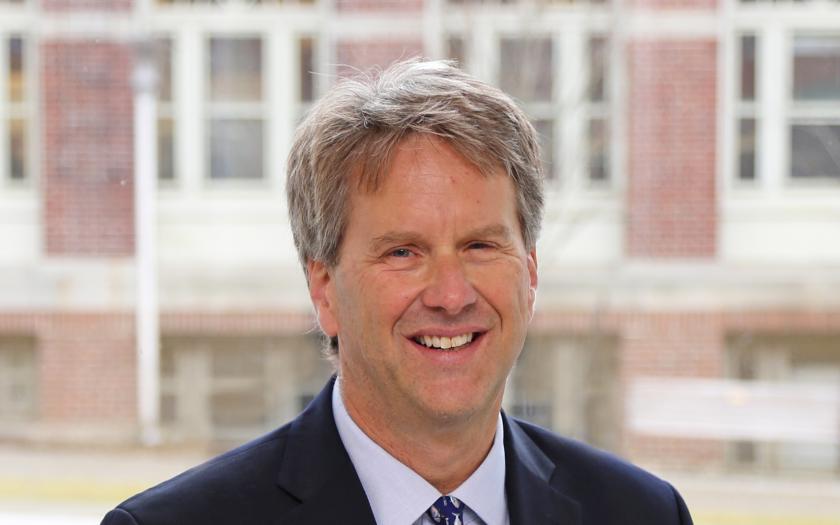October Faculty Spotlight - Braden Fleming

Bio
Braden Fleming joined the Department of Orthopedics at Brown University in June 2003. He received his doctorate in Mechanical Engineering from the University of Vermont in 1996, and then served on the faculty of the Department of Orthopaedics & Rehabilitation at the University of Vermont for seven years. He is the Co-Director of the Bioengineering Core of the COBRE for Skeletal Health and Repair. Most of his work has been funded by the NIH, DoD, and NFL Charities. He has received several awards for his research including the Kappa Delta Award (2013; 1994); Cabaud Research Award (2013; 2009), ACL Study Group Traveling Fellowship (2010-2012); the O'Donogue Research Award (2005); the Bruce Selya Research Award (2005), GOTS-Beiersdorf Research Award (2000), the American Society of Biomechanics Post-doctoral Young Scientist Award (1999), and the Albert Trillat Young Investigator Award (1997).
1) When did you know you wanted to be a biomedical engineer/researcher?
When I was a junior in high school, I had a serious finger injury. Because the hospital was overfilled, I was treated in a nurses’ lounge. I talked to a nurse and told her about my interests, and she suggested biomedical engineering to me. That set the stage and once I got a taste of research experience at UVM I fell in love with the field and it sealed the deal.
2) Of all of the publications you have written, is there one that you are most proud of? Why?
I’m most enthusiastic about one that came out last winter on a bridge-enhanced ACL repair (BEAR) technique that we’ve been working on. In 2007 Dr. Martha Murray approached me about doing some biomechanical testing and then one thing led to another and now we have this new BEAR technique. We worked to get it through the FDA and did the preclinical testing here at Brown and then a clinical trial at Boston Children’s Hospital. From the clinical trial we published a 10 page safety study with 3-month outcomes. This project has been a great example of identifying an important clinical question, determining how we should address the question, what steps are needed to find an answer and ultimately translating our research to patient care.
[The BEAR procedure is a fascinating technique. In your mind is it an example of regenerative medicine?]
I would say yes. It has the components. I’ve been asked if its tissue engineering and I think it can be catergorized as that, though perhaps its more general. Instead of growth factors it uses blood and platelets, but there’s a scaffold component and it encourages growth and healing in an environment that doesn’t necessarily heal on its own. We did studied that showed that platelet enriched plasma had improved officacy over single growth factors which we predict is because the platelets bring multiple growth factors and enzymes. It also showed that 1X concentration of platelet enriched plasma worked better than 5X. Nature uses blood and blood clots for a reason. This system works in so many cases so why would we try to improve on that when we could just use what works and create a system that delivers it where it needs to be.
[What is the next step of this project?]
We want to start a new randomized trial that will allow us to move into adult patients as it is currently only approved for children. Ultimately this will also ideally have potential applications in other systems.
3) Did you ever do experiments that didn’t work?
A lot of experiments don’t work. Try to block those out. When you try to do an experiment, you think it’s going to work. I’m interested in trying to non-invasively measure the mechanical properties of ligaments and tendons. When we first started all of the concepts seemed good so we dove right in, but our first attempts did not work as we expected. We realized that we probably didn’t know enough or the right things, but then those experiences are helpful too. I think you run into obstacles here and there in research but they shouldn’t stop you. I ask questions about what went wrong and what I learned and then I go from there.
4) How do you choose the projects your group works on?
A lot of our projects are determined by what we receive funding for and we have many spin offs from those projects. We are working on a project on MRI imaging of ligaments that developed as a spin off of the BEAR project to be able to measure mechanical properties of the ligaments in clinical trials since they can’t be harvested and measured in the same way they are in preclinical trials.
5) What three qualities are most important for ensuring success as a young researcher?
Inquisitive, enthusiastic, driven